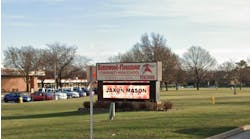Wired glass is almost as common in schools as dry-erase boards. You see it in classroom doors, administration windows and corridor lights. Whenever codes have dictated the use of fire-rated glazing, wired glass has been the predominant choice. It has been a reliable, economical solution in the promotion of life safety.
So it undoubtedly came as a surprise to some when the International Building Code (IBC, section 2406) adopted new standards that eliminate the use of traditional wired glass in K-12 schools, daycare centers and athletic facilities. How could such a popular product fall out of favor so quickly and completely?
The answer lies not in how wired glass responds to fire, but how it responds to human impact. Contrary to public perception, wired glass is not “breakproof.” The wires often are misinterpreted as adding a level of security, when in fact they only are there to hold the glass in place during a fire. Actually, wired glass breaks quite easily, and the wires can cause significant injuries by forming dangerous snags when the glass is broken.
That's bad news for a school corridor full of active students, running and jostling each other on the way to class. Glass in that setting is likely to encounter a great deal of physical contact. On a day-to-day basis, there's a much greater risk of breakage from human impact than from fire. If wired glass is being used, the threat of serious injury increases.
Some history
For a long time, wired glass was the only fire-rated glazing material available. No other glass could endure the intense heat of a fire without vacating the opening. Because nothing was available that could meet both types of code requirements, the CPSC gave wired glass a special exemption from impact-safety standards. Fire safety was considered the more pressing need.
But times changed. Newer, “wireless” glass products, the result of advanced technology, could withstand both fire and impact. Although it looks like typical window glass when installed, these products have capabilities far beyond traditional glass.
In addition to new glass options arising, statistical evidence regarding wired glass-related injuries began to mount. As the new IBC was being formed, a special ad-hoc committee reviewed the data related to wired-glass injuries. They discovered that the majority of incidents occurred in schools or athletic facilities.
One parent of a student who suffered permanent nerve damage from broken wired glass spearheaded a grassroots campaign to have the exemption removed.
The committee recommended curtailing the CPSC exemption, and the International Code Council (ICC) accepted its recommendation. All glass in “hazardous locations” of schools and athletic facilities now will be required to offer high-impact safety. The exemption still applies to other commercial facilities, although there is an effort being lobbied to remove that exemption as well.
Responding to change
Many glass products on the market are suitable substitutes for wired glass. Many of them surpass wired glass in their ability to withstand fire and impact. Further, because these products are wireless, they offer aesthetic advantages as well.
One alternative to wired glass isn't glass at all — it's ceramic. Thanks to art-class kilns, many students are familiar with ceramic's ability to withstand heat. That is why ceramic has become a favorite material for use in such “hot spots” as cook tops and high-performance car engines. Fire-rated glass ceramic offers the heat resistance of everyday ceramic with an appearance similar to clear window glass. With a very low expansion coefficient, glass ceramic has been able to earn fire ratings up to three hours. Laminated ceramics also provide high-impact safety and typically can be specified in sizes much larger than wired glass.
One of the advantages of these products is that, like wired glass, they can be cut in the field. Tempered glass and other wireless fire-rated glazing materials usually do not have that flexibility. School districts that have been accustomed to stocking wired glass now can stock fire-rated glass ceramic in a similar fashion, easing the transition away from the low-impact wired glass.
Ceramics are not the only alternative to wired glass. Another category of glazing now on the market could be classified as glass fire walls. These multilayer units resemble bullet-resistant glass from the edge, and they offer fire ratings up to two hours. Tested to the same standards as solid-barrier walls, glass fire walls block heat in addition to flames and smoke. As a result, architects now can specify unrestricted amounts of glass where ordinarily they would need to restrict glass to less than 25 percent of the wall area. Fully transparent doors with ratings up to 90 minutes are now a reality.
Glass fire walls also now are available with bullet resistance and security ratings. This is a real breakthrough, because most security glass contains highly flammable plastics, which can hinder efforts to contain a fire. Having a single product that can provide protection from fire, impact and bullets, gives schools a powerful tool for creating a safer learning environment.
Code officials have noticed that some contractors have tried to overcome the drawbacks of wired glass by applying a safety film to it in the field. However, such a solution has its own problems, because most films also are plastic and highly flammable. The fire rating of the glass could be nullified in an effort to provide impact safety. Unless a film product has been tested successfully for both impact and fire safety with wired glass at an independent laboratory such as UL, it should not be applied in a fire-rated location. At least one wired-glass manufacturer has issued a memo indicating they will not stand behind the fire rating of their product if someone applies a film to it after it leaves the factory.
Fire-rated glass with surface-applied film is appropriate for many commercial applications, but schools can be more susceptible to abuse than other types of facilities. Even the toughest films can be marred, peeled or damaged by a determined vandal. Students who discover a loose corner of the film may pick at it and separate it from the glass. When the film is damaged, it is unsightly and may impair the performance ability of the product, which could invalidate its fire or safety ratings.
What to do
What will this mean for schools? Initially, it probably will create some challenges. Different supply chains may need to be established. Institutions will need to learn the characteristics, limitations and listings of new products, and they will need to incorporate code changes.
Determining the appropriate product for a particular school will depend on several factors:
-
Fire rating
Not all fire-rated glass has been tested to the same standards. Verify the fire rating required for an opening, and make sure the glass specified meets those requirements without special qualifications or disclaimers. Glass in doors, sidelites and near floors is at the greatest risk for breakage and needs to be able to withstand high impact.
-
Impact rating
There are different levels of protection. Depending on the location of the glass, you may need greater impact resistance. Again, check the code requirements carefully.
-
Maintenance
If a glass product that has a surface-applied film is used, expect greater maintenance needs. More durable products are preferable. There frequently is a difference between initial cost and long-term value. Also, keep in mind whether or not a product can be stocked for quick replacements when breakage occurs.
In the long run, school design stands to benefit from the change in codes. The alternatives to wired glass bring options in fire-rated openings that were never before possible. Schools will be able to incorporate products that reduce liability and improve aesthetics. Permanent labels on the wireless fire-rated glazing options also will provide for easy identification by code and fire officials.
Razwick is president of Technical Glass Products in Kirkland, Wash., a national distributor for some of the world's largest manufacturers of fire-rated glass and framing products.

